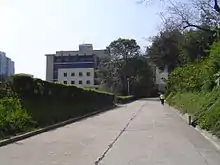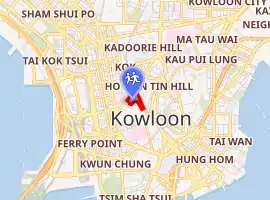Wah Yan College, Kowloon
Wah Yan College, Kowloon (WYK; Chinese: 九龍華仁書院; demonym: Wahyanite, pl.: Wahyanites) is a Roman Catholic secondary school for boys run by the Chinese Province of the Society of Jesus. Located at 56 Waterloo Road, Yau Ma Tei, Kowloon, it is a grant-in-aid secondary school using English as the primary medium of instruction.

| Wah Yan College, Kowloon 九龍華仁書院 (Chinese) | |
|---|---|
 | |
| Address | |

| |
Hong Kong | |
| Coordinates | 22.314577°N 114.17351°E |
| Information | |
| School type | Grant-in-aid, Secondary school |
| Motto | In Hoc Signo Vinces (Latin) ("In this sign you will conquer"[1]) |
| Religious affiliation(s) | Roman Catholic (Jesuits) |
| Established | 1924 |
| Founder | Tsui Yan Sau Peter |
| Status | Active |
| Authority | Society of Jesus |
| Medium of instruction | English |
| School code | WYK |
| President | Rev.Fr. Stephen S.Y. Chow,SJ (Supervisor) |
| Principal | Mr Chung Wai-leung, Warren |
| Grades | F.1 – F.6 (Formerly F.1 - F.7) |
| Gender | Male |
| Campus size | 41,000 m2 (440,000 sq ft) |
| Colour(s) | Green |
| Sports | Athletics, baseball, basketball, football, badminton, cross country, fencing, orienteering, swimming, table tennis, ice hockey, water polo, tennis |
| Yearbook | The Shield |
| Alumni | See below |
| Brother school | Wah Yan College, Hong Kong |
| Website | www |
| Wah Yan College, Kowloon | |||||||||||
|---|---|---|---|---|---|---|---|---|---|---|---|
| Traditional Chinese | 九龍華仁書院 | ||||||||||
| Simplified Chinese | 九龙华仁书院 | ||||||||||
| |||||||||||
History
Formative years
Established in 1924 as a branch of Wah Yan College, Hong Kong by Mr. Peter Tsui Yan Sau (徐仁壽, formerly a teacher at St. Joseph's College), Wah Yan College Kowloon is one of the oldest and most prestigious secondary schools in Hong Kong, and was the first English-speaking college to be administered by local Chinese. During the 1930s, Mr. Tsui, himself a devout Catholic, saw the need of the pupils for greater spiritual guidance, and decided to gradually hand over the administration to the incoming Jesuits who were looking to serve in some local educational establishments. Besides the two Wah Yan Colleges, the Jesuits also sought to form a Catholic University in Hong Kong. But with the University of Hong Kong already established in 1911, the Jesuit fathers turned to organizing a Catholic hostel for its male students, which became Ricci Hall of the University . Mr. Tsui left Hong Kong and became a successful rubber planter and hotelier in Kota Kinabalu, British North Borneo (now Sabah, Malaysia). He died in Hong Kong on 19 February 1981, at the age of ninety three.
Pre-war developments
Before the Second World War, the school was located on Portland Street and then moved to Nelson Street in 1928. Under the auspices of A. E. Wood, Secretary for Education, the school was added to the Grant List and hence under Government subsidies. A branch was opened on Austin Road 103 to cater students in senior year. The premises became Tak Sun Primary School after the war. A South China Morning Post article in 1928 reported WYK to be the largest school in Hong Kong with a student population of 500. Despite new facilities, however, seniors had to cross Victoria Harbour for laboratory lessons at the Wah Yan College, Hong Kong.
In 1941 when Hong Kong was attacked by the Japanese forces, the Jesuits of the College helped organise the evacuation of the Kowloon civilians to the Island as they closed down the school. During the occupation, the Japanese prohibited its resumption on political grounds. The Nelson Street campus was so thoroughly looted that Mr. Chow Ching-nam (周淸霖), then Principal, could only salvage a small portion of school registers and documents, and the students had to bring in their own chairs when the College reopened after the war.
Expansion and maturity
Around 1947, the school authorities began the search for a new campus as its enrolment further increased. A proposed acquisition of a site on Ho Man Tin Hill Road was turned down. After negotiations with the Government of Hong Kong, a piece of former paddy field was granted and it moved to the current premises on Waterloo Road in 1952. This portion of land was large by Hong Kong standards, making WYK one of the largest campus in the urban Hong Kong area. This precedent was soon followed in the case of land provision for the Hong Kong campus, where the plot granted by the Government was also of significant size. The present campus was opened by the then Governor Sir Alexander Grantham in 1953. In 2005 a new annex of WYK was opened providing new science labs, a music room, a computer-assisted learning (CAL) room, and a student activity room.
Mr. Laurence Tam (譚志成), an arts teacher during the late 1960s, pioneered a new Chinese ink painting movement which he integrated in his curriculum experimentally. He left the school to work as a curator at the Hong Kong Museum of Art in 1971.
The school hymn of Wah Yan College Kowloon is Our Captain and Our King. The origin of the hymn is unclear, but it is believed to have originated from Northern England back in the 18th century.[2]
| Verse 1
Our Captain and our King, We kneel in love before Thee. Our hearts in tribute bring Glad homage here to pay. O do not Thou disdain The giftso mean, so poor; More precious far we fain Would offer and more pure.
Our deep love, O Lord Till this our life is o'er Be Thine forever more, be Thine forever more, Yes, Thine forever more.
Grant us, we pray, Thy cause To champion, though so lowly, Nor ever fail nor pause, When trials throng and press. O God of battle, smite, And nerve us for the fray; O Prince of Peace, thy light Can ev'ry toil repay.
|

with the new additions Law Ting Pong building (right)
Notable alumni
Current Legislative Council Members
- TO James Kun-sun (涂謹申), member of the Legislative Council (Kowloon West)
- TSE Paul (謝偉俊), member of the Legislative Council (Tourism Functional Constituency)
- Ho Kai-ming (何啟明), member of the Legislative Council (Labour Functional Constituency)
Politics
- LAU Hon-chuen (劉漢銓), former chairman of the Hong Kong Progressive Alliance
- LEE Martin Chu-ming (李柱銘), founding chairman of the Democratic Party
- LEE Philip S. (李紹麟), former Lieutenant Governor of Manitoba, Canada
- LEE Yeh-kwong (李業廣), former member of the Executive Council of Hong Kong and former Chairman of Hong Kong Exchanges and Clearing Limited
- LEONG Alan Kah-kit (梁家傑), former leader of the Civic Party, former chairman of the Hong Kong Bar Association and candidate for Hong Kong Chief Executive Election in 2007
- SHIU Sin-por, head of the Central Policy Unit
- WONG Ernest Kwok Chung (王國忠), member of the New South Wales Legislative Council, Australia
Law
- LEONG Arthur Siu-chung (梁紹中) GBS, Chief Judge of the High Court (2000-2003)
- Lee, Martin Chu-Ming, senior counsel
- Neoh, Anthony, senior counsel
- Ho, Ambrose Pui-Him, senior counsel
- Leong, Alan Kah-Kit, senior counsel
- Lee, Robert, senior counsel
- Hui, Martin, senior counsel
Business
- CHAN John Cho-chak (陳祖澤), former chairman of Hong Kong Jockey Club;[3] former managing director of Kowloon Motor Bus (1933) Ltd.
- NG Stephen Tin-hoi(吳天海), deputy chairman and managing director of Wharf Holdings Limited (九龍倉集團有限公司); chairman, deputy chairman of Wheelock and Company Limited (會德豐有限公司)
- YING Michael Lee-Yuen (刑李源), former chairman of Esprit Holdings Limited.
- YUEN Tin-fan (袁天凡), former CEO of Hong Kong Stock Exchange
Academics
- MAK Tak Wah (class of 1962), scientist (discoverer of T cell receptors, a key component of the human immune system),[4][5][6]
- TSO Wung-Wai, an adjunct professor at the Chinese University of Hong Kong, also an active politician in Hong Kong
- WONG John Y. (黃宇和), emeritus professor in the Department of History at the University of Sydney and Fellow of the Academy of Social Sciences in Australia
- Leung Tsang is presently a professor of electrical engineering and computer science at the University of Michigan, Ann Arbor. Leung Tsang was born in Hong Kong. He completed high school at Wah Yan College, Kowloon, Hong Kong. He received the SB, SM, EE, and Ph.D. degrees all from the Department of Electrical Engineering and Computer Science of the Massachusetts Institute of Technology. He was an assistant/associate professor of electrical engineering at Texas A&M University, College Station, Texas in 1980–1983. He was a professor of electrical engineering at the University of Washington, Seattle, in 1983–2014, and was the department chair of UWEE in 2006–2011. Between 2001 and 2004, he was on leave from University of Washington and was a professor chair at the Department of Electronic Engineering of the City University of Hong Kong. He was the editor-in-chief of the IEEE Transactions on Geoscience and Remote Sensing in 1996–2000. He was the president of IEEE Geoscience and Remote Sensing Society 2006–2007. Since April 2008, he has been the president of the Electromagnetics Academy, Cambridge, Massachusetts.[7]
- Dr SO Ting Pat Albert 蘇廷弼.
Art and performance
- CHAN Koon Chung (陳冠中), author of "The Fat Years (盛世)"
- Kenneth TSANG (曾江), actor in Hollywood productions such as Die Another Day
- Jeffrey NGAI(魏鵬展),poet, founder of the Poem and Novel (小說與詩) magazine
- Brendan Lai (黎達沖), Grand Master of the Northern Seven Stars Praying Mantis Kung Fu[8] system, 8th generation, a disciple of Wong Hon Fan (黃漢勛).[9]
- CHAN Ka Hei (陳家曦), famous local composer
See also
References
- [Different from Wah Yan College, Hong Kong: In this sign you shall conquer]
- "WYHYMN". www.interlog.com. Retrieved 10 March 2020.
- "Big shoes to fill for new club boss". Hong Kong Standard. 31 August 2010. Retrieved 31 August 2010.
- http://www.science.ca/scientists/scientistprofile.php?pID=15
- http://citzine.ca/stuff.php?lng=e&sub=2&cid=55
- http://medbio.utoronto.ca/faculty/mak.html
- https://web.eecs.umich.edu/~leutsang/
- Northern Praying Mantis"
- http://www.theravenswoodacademy.com/history-archive
External links
| Wikimedia Commons has media related to Wah Yan College, Kowloon. |